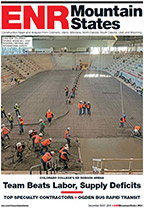The market for subcontractors and specialty-trade contractors has been slowly improving for the past five years. During the uphill climb, many contractors wondered when things would get back to normal. That day has arrived. Not all markets or conditions are ideal, but the market is strong, and most firms no longer have to worry about the bottom falling out of their business.
|
View the complete Top 600 List with data and analysis (subscription required) |
The scope of the recovery can be seen in the results of this year’s ENR Top 600 Specialty Contractors list. As a group, the Top 600 cleared revenue of $93.20 bil-lion in 2014, up 5.6%, from $88.13 billion, in 2013. The Top 600 revenue figure from 2014 is a record and well ahead 2008’s mark of $87.07 billion—before the great recession began.
Part of the growth can be attributed to acquisitions by the large firms at the top of the list. For example, Quanta Services, the No. 1 firm on the list, acquired nine firms in 2014, including Canada’s Banister Pipelines, which Quanta anticipates will generate as much as $350 million in revenue in 2015. Another large firm on the acquisition trail was Safway Group. It acquired Canadian insulation contractor Nel-Tekk in 2014 and recently acquired painting giant Mobley Industrial Services, which Safway says is the largest independently owned coatings company in the U.S. “The acquisition of proven performers like Mobley Industrial Services in the Gulf region and Nel-Tekk inOntario has helped to round out Safway’s multiservice expertise and elevate our leadership in the industry,” says Bill Hayes, Safway’s CEO.
It is not just the big firms that are making acquisitions. For example, last December, O’Connell Electric Co. acquired Clifford R. Gray, a union electrical and communications contractor based in Schenectady, N.Y. “O’Connell has been strategically positioning [itself] in the industry to increase [its] overall company sales to a quarter-billion dollars over the next several years,” says Victor Salerno, O’Connell’s CEO.
However, not all firms are in a hurry to grow through acquisition. “We are always looking for good firms that could provide value to us, but we prefer to grow organically,” says Anthony Guzzi, CEO of EMCOR Group. He sees EMCOR growing internally in this market at a solid but single-digit pace.
However, Guzzi warns that contractors should always be prepared for a sudden shift in fortunes. “The market is growing, but with all the turmoil in the world, there could be an abrupt shift. I think we have all learned to live with that possibility,” he says. Still, he does not believe the scale of problems that stemmed from the 2008 economic meltdown will revisit the market. “Who would have thought that we would [experience] a series of crises in the Middle East and the market here would remain unaffected?” he observes.
Many firms believe the market for subcontractors will remain strong for at least another year. Robert V. Barnes III, CEO of Dee Brown Inc., notes that general contractors have been loading up their backlogs for projects as far out as spring and summer 2017, providing an unusually long lead in buyout for the subcontractor. “We
generally experience the time from award to install something more in the four- to six-month lead-time range, but that is now stretching out to 15 to 18 months,” he says.
Still Competitive
Despite the growing availability of work, competition remains intense. Over the past few years, contractors competed vigorously just to maintain their business. But now, “competition remains strong as companies regain their appetite for growth,” says Joel Moryn, president of Parsons Electric.
Some contractors worry that some of their competitors may be overreaching. “There are many firms out there reaching for much higher volumes and larger single project awards that don’t have the past history to support their claims,” says Barnes.







Post a comment to this article
Report Abusive Comment